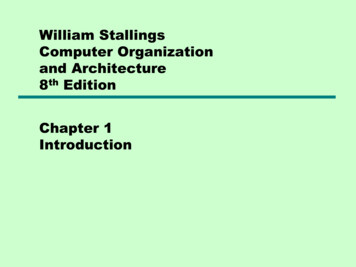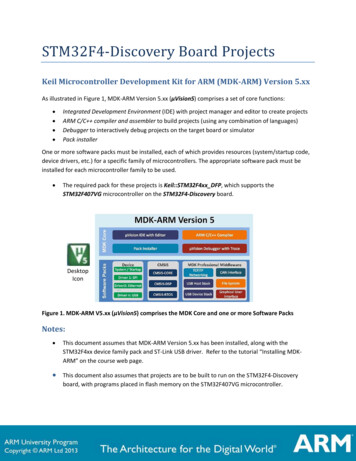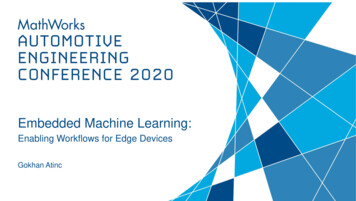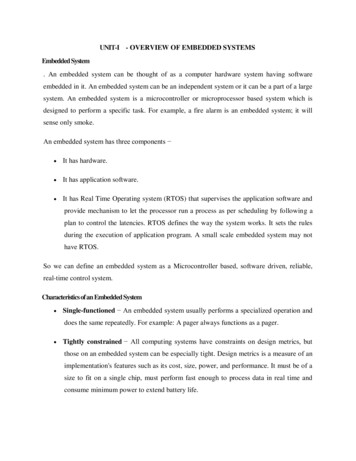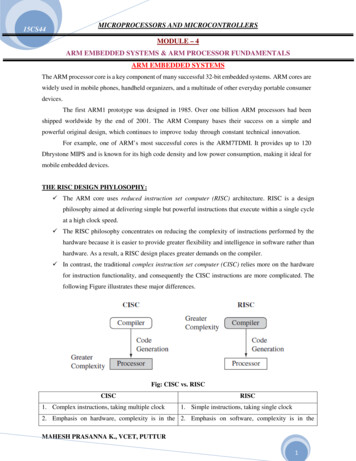
Transcription
MICROPROCESSORS AND MICROCONTROLLERS15CS44MODULE – 4ARM EMBEDDED SYSTEMS & ARM PROCESSOR FUNDAMENTALSARM EMBEDDED SYSTEMSThe ARM processor core is a key component of many successful 32-bit embedded systems. ARM cores arewidely used in mobile phones, handheld organizers, and a multitude of other everyday portable consumerdevices.The first ARM1 prototype was designed in 1985. Over one billion ARM processors had beenshipped worldwide by the end of 2001. The ARM Company bases their success on a simple andpowerful original design, which continues to improve today through constant technical innovation.For example, one of ARM’s most successful cores is the ARM7TDMI. It provides up to 120Dhrystone MIPS and is known for its high code density and low power consumption, making it ideal formobile embedded devices.THE RISC DESIGN PHYLOSOPHY: The ARM core uses reduced instruction set computer (RISC) architecture. RISC is a designphilosophy aimed at delivering simple but powerful instructions that execute within a single cycleat a high clock speed. The RISC philosophy concentrates on reducing the complexity of instructions performed by thehardware because it is easier to provide greater flexibility and intelligence in software rather thanhardware. As a result, a RISC design places greater demands on the compiler. In contrast, the traditional complex instruction set computer (CISC) relies more on the hardwarefor instruction functionality, and consequently the CISC instructions are more complicated. Thefollowing Figure illustrates these major differences.Fig: CISC vs. RISCCISC1. Complex instructions, taking multiple clockRISC1. Simple instructions, taking single clock2. Emphasis on hardware, complexity is in the 2. Emphasis on software, complexity is in theMAHESH PRASANNA K., VCET, PUTTUR1
MICROPROCESSORS AND ier3. Complex instructions, instructions executed by 3. Reduced instructions, instructions executed bymicro-program/processorhardware4. Variable format instructions, single register set 4. Fixed format instructions, multiple register setsand many instructions5. Many instructions and many addressing modesand few instructions5. Fixed instructions and few addressing modes6. Conditional jump is usually based on status 6. Conditional jump can be based on a bitregister bitanywhere in memory7. Memory reference is embedded in many 7. MemoryinstructionsreferenceisembeddedinLOAD/STORE instructionsThe RISC philosophy is implemented with four major design rules:1. Instructions—RISC processors have a reduced number of instruction classes. These classesprovide simple operations that can each execute in a single cycle. The compiler or programmersynthesizes complicated operations (for example, a divide operation) by combining severalsimple instructions. Each instruction is having fixed length to allow the pipeline to fetch futureinstructions before decoding the current instruction.oIn contrast, in CISC processors the instructions are often of variable size and take manycycles to execute.2. Pipelines—The processing of instructions is broken down into smaller units that can be executedin parallel by pipelines. Ideally the pipeline advances by one step on each cycle for maximumthroughput. Instructions can be decoded in one pipeline stage.oThere is no need for an instruction to be executed by a mini-program called microcode ason CISC processors.3. Registers—RISC machines have a large general-purpose register set. Any register can containeither data or an address. Registers act as the fast local memory store for all data processingoperations.oIn contrast, CISC processors have dedicated registers for specific purposes.4. Load-store architecture—The processor operates on data held in registers. Separate load andstore instructions transfer data between the register bank and external memory. Memory accessesare costly, so separating memory accesses from data processing provides an advantage becauseyou can use data items held in the register bank multiple times without needing multiple memoryaccesses.oIn contrast, with a CISC design the data processing operations can act on memorydirectly.MAHESH PRASANNA K., VCET, PUTTUR2
MICROPROCESSORS AND MICROCONTROLLERS15CS44 These design rules allow a RISC processor to be simpler, and thus the core can operate at higherclock frequencies.oIn contrast, traditional CISC processors are more complex and operate at lower clockfrequencies.THE ARM DESIGN PHYLOSOPHY:There are a number of physical features that have driven the ARM processor design. Portable embedded systems require battery power. The ARM processor has been speciallydesigned to be small to reduce power consumption and extend battery operation—essential forapplications such as mobile phones and personal digital assistants (PDAs). High code density is another major requirement since embedded systems have limited memorydue to cost and/or physical size restrictions—useful for applications that have limited on-boardmemory, such as mobile phones and mass storage devices. Embedded systems are price sensitiveoHence, use slow and low-cost memory devices to get substantial savings—essential forhigh-volume applications like digital cameras.oAlso, reduce the area of the die taken up by the embedded processor; smaller the areaused by the embedded processor, reduced cost of the design and manufacturing for theend product. ARM has incorporated hardware debug technology within the processor so that softwareengineers can view what is happening while the processor is executing code. With greatervisibility, software engineers can resolve issues faster. The ARM core is not a pure RISC architecture because of the constraints of its primaryapplication—the embedded system. In some sense, the strength of the ARM core is that it doesnot take the RISC concept too far.Instruction Set for Embedded Systems:The ARM instruction set differs from the pure RISC definition in several ways that make the ARMinstruction set suitable for embedded applications: Variable cycle execution for certain instructions—Not every ARM instruction executes in asingle cycle. For example, load-store-multiple instructions vary in the number of execution cyclesdepending upon the number of registers being transferred. The transfer can occur on sequentialmemory addresses. Code density is also improved since multiple register transfers are commonoperations at the start and end of functions.MAHESH PRASANNA K., VCET, PUTTUR3
MICROPROCESSORS AND MICROCONTROLLERS15CS44 Inline barrel shifter leading to more complex instructions—The inline barrel shifter is a hardwarecomponent that preprocesses one of the input registers before it is used by an instruction. Thisexpands the capability of many instructions to improve core performance and code density. Thumb 16-bit instruction set—ARM enhanced the processor core by adding a second 16-bitinstruction set called Thumb that permits the ARM core to execute either 16- or 32-bitinstructions. The 16-bit instructions improve code density by about 30% over 32-bit fixed-lengthinstructions. Conditional execution—An instruction is only executed when a specific condition has beensatisfied. This feature improves performance and code density by reducing branch instructions. Enhanced instructions—The enhanced digital signal processor (DSP) instructions were added tothe standard ARM instruction set to support fast 16 16-bit multiplier operations. Theseinstructions allow a faster-performing ARM processor.These additional features have made the ARM processor one of the most commonly used 32-bitembedded processor cores.EMBEDDED SYSTEM HARDWARE:Embedded systems can control many different devices, from small sensors found on a production line, tothe real-time control systems used on a NASA space probe. All these devices use a combination ofsoftware and hardware components.The following Figure shows a typical embedded device based on an ARM core. Each box represents afeature or function. The lines connecting the boxes are the buses carrying data.Figure: An ARM-based Embedded Device, a MicrocontrollerMAHESH PRASANNA K., VCET, PUTTUR4
MICROPROCESSORS AND MICROCONTROLLERS15CS44We can separate the device into four main hardware components:1. The ARM processor controls the embedded device. Different versions of the ARM processor areavailable to suit the desired operating characteristics. An ARM processor comprises a core (theexecution engine that processes instructions and manipulates data) plus the surroundingcomponents (memory and cache) that interface it with a bus.2. Controllers coordinate important functional blocks of the system.Two commonly foundcontrollers are interrupt and memory controllers.3. The peripherals provide all the input-output capability external to the chip and are responsible forthe uniqueness of the embedded device.4. A bus is used to communicate between different parts of the device.ARM Bus Technology:Embedded devices use an on-chip bus that is internal to the chip and that allows different peripheraldevices to be interconnected with an ARM core.There are two different classes of devices attached to the bus:1. The ARM processor core is a bus master—a logical device capable of initiating a data transferwith another device across the same bus.2. Peripherals tend to be bus slaves—logical devices capable only of responding to a transferrequest from a bus master device.A bus has two architecture levels:A physical level—covers the electrical characteristics and bus width (16, 32, or 64 bits).The protocol—the logical rules that govern the communication between the processor and a peripheral.AMBA Bus Protocol: The Advanced Microcontroller Bus Architecture (AMBA) was introduced in 1996 and has beenwidely adopted as the on-chip bus architecture used for ARM processors. The first AMBA buses introduced were the ARM System Bus (ASB) and the ARM Peripheral Bus(APB). Later ARM introduced another bus design, called the ARM High Performance Bus(AHB). Using AMBA, peripheral designers can reuse the same design on multiple projects. A peripheralcan simply be bolted onto the on-chip bus without having to redesign an interface for eachdifferent processor architecture. This plug-and-play interface for hardware developers improvesavailability and time to market. AHB provides higher data throughput than ASB because it is based on a centralized multiplexedbus scheme rather than the ASB bidirectional bus design. This change allows the AHB bus to runat higher clock speeds.MAHESH PRASANNA K., VCET, PUTTUR5
MICROPROCESSORS AND MICROCONTROLLERS15CS44 ARM has introduced two variations on the AHB bus: Multi-layer AHB and AHB-Lite.oThe Multi-layer AHB bus allows multiple active bus masters.oAHB-Lite is a subset of the AHB bus and it is limited to a single bus master. The example device shown in the above Figure has three buses:oan AHB bus for the high- performance peripheralsoan APB bus for the slower peripheralsoa third bus for external peripherals, proprietary to this device.Memory:An embedded system has to have some form of memory to store and execute code. You have to compareprice, performance, and power consumption when deciding upon specific memory characteristics, such ashierarchy, width, and type.Hierarchy: All computer systems have memory arranged in some form of hierarchy. The followingFigure shows the memory trade-offs: the fastest memory cache is physically located nearer the ARMprocessor core and the slowest secondary memory is set further away. Generally the closer memory is tothe processor core, the more it costs and the smaller its capacity.Figure: Memory Storage Trade-offs The cache is placed between main memory and the core. It is used to speed up data transferbetween the processor and main memory. A cache provides an overall increase in performancebut with a loss of predictable execution time. Although the cache increases the generalperformance of the system, it does not help real-time system response. The main memory is large—around 256 KB to 256 MB (or even greater), depending on theapplication—and is generally stored in separate chips. Load and store instructions access the mainmemory unless the values have been stored in the cache for fast access.MAHESH PRASANNA K., VCET, PUTTUR6
MICROPROCESSORS AND MICROCONTROLLERS15CS44 Secondary storage is the largest and slowest form of memory. Hard disk drives and CD-ROMdrives are examples of secondary storage.Width: The memory width is the number of bits the memory returns on each access—typically 8, 16, 32,or 64 bits. The memory width has a direct effect on the overall performance and cost ratio. Lower bitmemories are less expensive, but reduce the system performance.The following Table summarizes theoretical cycle times on an ARM processor using different memorywidth devices.Table: Fetching Instruction from MemoryInstruction Size 8-bit Memory 16-bit Memory 32-bit MemoryARM 32-bit4 cycles2 cycles1 cyclesThumb 16-bit2 cycles1 cycles1 cyclesTypes: There are many different types of memory: Read-only memory (ROM) is the least flexible of all memory types because it contains an imagethat is permanently set at production time and cannot be reprogrammed.oROMs are used in high-volume devices that require no updates or corrections. Many devices alsouse a ROM to hold boot code. Flash ROM can be written to as well as read, but it is slow to write so you shouldn’t use it forholding dynamic data.oIts main use is for holding the device firmware or storing long-term data that needs to be preservedafter power is off. The erasing and writing of flash ROM are completely software controlled withno additional hardware circuitry required, which reduces the manufacturing costs. Dynamic random access memory (DRAM) is the most commonly used RAM for devices. It hasthe lowest cost per megabyte compared with other types of RAM. DRAM is dynamic—it needsto have its storage cells refreshed and given a new electronic charge every few milliseconds, soyou need to set up a DRAM controller before using the memory. Static random access memory (SRAM) is faster than the more traditional DRAM, but requiresmore silicon area. SRAM is static—the RAM does not require refreshing. The access time forSRAM is considerably shorter than the equivalent DRAM because SRAM does not require apause between data accesses. But cost of SRAM is high. Synchronous dynamic random access memory (SDRAM) is one of many subcategories of DRAM.It can run at much higher clock speeds than conventional memory. SDRAM synchronizes itselfwith the processor bus, because it is clocked. Internally the data is fetched from memory cells,pipelined, and finally brought out on the bus in a burst.MAHESH PRASANNA K., VCET, PUTTUR7
MICROPROCESSORS AND MICROCONTROLLERS15CS44Peripherals:Embedded systems that interact with the outside world need some form of peripheral device. Aperipheral device performs input and output functions for the chip by connecting to other devices orsensors that are off-chip.oEach peripheral device usually performs a single function and may reside on-chip.oPeripherals range from a simple serial communication device to a more complex 802.11wireless device. All ARM peripherals are memory mapped—the programming interface is a set of memoryaddressed registers. The address of these registers is an offset from a specific peripheral baseaddress. Controllers are specialized peripherals that implement higher levels of functionality within anembedded system.oTwo important types of controllers are memory controllers and interrupt controllers.Memory Controllers: Memory controllers connect different types of memory to the processor bus.oOn power-up a memory controller is configured in hardware to allow certain memory devices tobe active. These memory devices allow the initialization code to be executed.Some memory devices must be set up by software; for example, when using DRAM, you first have to setup the memory timings and refresh rate before it can be accessed.Interrupt Controllers: When a peripheral or device requires attention, it raises an interrupt to theprocessor. An interrupt controller provides a programmable governing policy that allows software todetermine which peripheral or device can interrupt the processor at any specific time by setting theappropriate bits in the interrupt controller registers.There are two types of interrupt controller available for the ARM processor: the standard interruptcontroller and the vector interrupt controller.1. The standard interrupt controller sends an interrupt signal to the processor core when an externaldevice requests servicing. It can be programmed to ignore or mask an individual device or set ofdevices.oThe interrupt handler determines which device requires servicing by reading a devicebitmap register in the interrupt controller.2. The vector interrupt controller (VIC) is more powerful than the standard interrupt controller,because it prioritizes interrupts and simplifies the determination of which device caused theinterrupt.oDepending on the type, the VIC will either call the standard interrupt exception handler,which can load the address of the handler.MAHESH PRASANNA K., VCET, PUTTUR8
MICROPROCESSORS AND MICROCONTROLLERS15CS44EMBEDDED SYSTEM SOFTWARE:An embedded system needs software to drive it. The following Figure shows four typical softwarecomponents required to control an embedded device.Figure: Software Abstraction Layers Executing on Hardware The initialization code is the first code executed on the board and is specific to a particular targetor group of targets. It sets up the minimum parts of the board before handing control over to theoperating system. The operating system provides an infrastructure to control applications and manage hardwaresystem resources. The device drivers provide a consistent software interface to the peripherals on the hardwaredevice. An application performs one of the tasks required for a device.oFor example, a mobile phone might have a diary application.There may be multiple applications running on the same device, controlled by the operatingsystem.Initialization (Boot) Code: Initialization code (or boot code) takes the processor from the reset state to a state where theoperating system can run. It usually configures the memory controller and processor caches andinitializes some devices. The initialization code handles a number of administrative tasks prior to handing control over toan operating system image.oWe can group these different tasks into three phases: initial hardware configuration,diagnostics, and booting.1. Initial hardware configuration involves setting up the target platform, so that it can boot animage. The target platform comes up in a standard configuration; but, this configuration normallyrequires modification to satisfy the requirements of the booted image.MAHESH PRASANNA K., VCET, PUTTUR9
MICROPROCESSORS AND MICROCONTROLLERS15CS44oFor example, the memory system normally requires reorganization of the memory map,as shown in the following Example.Example: Initializing or organizing memory is an important part of the initialization code, because manyoperating systems expect a known memory layout before they can start.Figure: Memory RemappingThe above Figure shows memory before and after reorganization. It is common for ARM-based embeddedsystems to provide for memory remapping because it allows the system to start the initialization codefrom ROM at power-up. The initialization code then redefines or remaps the memory map to place RAMat address 0x00000000—an important step because then the exception vector table can be in RAM andthus can be reprogrammed.2. Diagnostics are often embedded in the initialization code. Diagnostic code tests the system byexercising the hardware target to check if the target is in working order. It also tracks downstandard system-related issues. The primary purpose of diagnostic code is fault identification andisolation.3. Booting involves loading an image and handing control over to that image. The boot processitself can be complicated if the system must boot different operating systems or different versionsof the same operating system.oBooting an image is the final phase, but first you must load the image. Loading an imageinvolves anything from copying an entire program including code and data into RAM, tojust copying a data area containing volatile variables into RAM. Once booted, the systemhands over control by modifying the program counter to point into the start of the image.MAHESH PRASANNA K., VCET, PUTTUR10
MICROPROCESSORS AND MICROCONTROLLERS15CS44Operating System: The initialization process prepares the hardware for an operating system to take control. Anoperating system organizes the system resources: the peripherals, memory, and processing time. ARM processors support over 50 operating systems. We can divide operating systems into twomain categories: real-time operating systems (RTOSs) and platform operating systems.1. RTOSs provide guaranteed response times to events. Different operating systems have differentamounts of control over the system response time.oA hard real-time application requires a guaranteed response to work at all.oIn contrast, a soft real-time application requires a good response time, but theperformance degrades more gracefully if the response time overruns.2. Platform operating systems require a memory management unit to manage large, non-real-timeapplications and tend to have secondary storage.oThe Linux operating system is a typical example of a platform operating system.Applications: The operating system schedules applications—code dedicated to handle a particular task. Anapplication implements a processing task; the operating system controls the environment.oAn embedded system can have one active application or several applications runningsimultaneously. ARM processors are found in numerous market segments, including networking, auto-motive,mobile and consumer devices, mass storage, and imaging. ARM processor is found in networking applications like home gateways, DSL modems for highspeed Internet communication, and 802.11 wireless communications. The mobile device segment is the largest application area for ARM processors, because of mobilephones. ARM processors are also found in mass storage devices such as hard drives and imaging productssuch as inkjet printers—applications that are cost sensitive and high volume. In contrast, ARM processors are not found in applications that require leading-edge highperformance. Because these applications tend to be low volume and high cost, ARM has decidednot to focus designs on these types of applications.MAHESH PRASANNA K., VCET, PUTTUR11
MICROPROCESSORS AND MICROCONTROLLERS15CS44ARM PROCESSOR FUNDAMENTALSA programmer can think of an ARM core as functional units connected by data buses, as shown in thefollowing Figure.Figure: ARM Core dataflow ModelThe arrows represent the flow of data, the lines represent the buses, and the boxes represent either anoperation unit or a storage area. Data enters the processor core through the Data bus. The data may be an instruction to executeor a data item.oFigure shows a Von Neumann implementation of the ARM—data items and instructionsshare the same bus. (In contrast, Harvard implementations of the ARM use two differentbuses). The instruction decoder translates instructions before they are executed. Each instructionexecuted belongs to a particular instruction set. The ARM processor, like all RISC processors, uses load-store architecture—means it has twoinstruction types for transferring data in and out of the processor:MAHESH PRASANNA K., VCET, PUTTUR12
MICROPROCESSORS AND MICROCONTROLLERS15CS44oload instructions copy data from memory to registers in the coreostore instructions copy data from registers to memory There are no data processing instructions that directly manipulate data in memory. Thus, dataprocessing is carried out in registers. Data items are placed in the register file—a storage bank made up of 32-bit registers.oSince the ARM core is a 32-bit processor, most instructions treat the registers as holdingsigned or unsigned 32-bit values. The sign extend hardware converts signed 8-bit and16-bit numbers to 32-bit values as they are read from memory and placed in a register. ARM instructions typically have two source registers, Rn and Rm, and a single result ordestination register, Rd. Source operands are read from the register file using the internal busesA and B, respectively. The ALU (arithmetic logic unit) or MAC (multiply-accumulate unit) takes the register values Rnand Rm from the A and B buses and computes a result. Data processing instructions write theresult in Rd directly to the register file. Load and store instructions use the ALU to generate an address to be held in the address registerand broadcast on the Address bus.oOne important feature of the ARM is that register Rm alternatively can be preprocessed inthe barrel shifter before it enters the ALU. Together the barrel shifter and ALU cancalculate a wide range of expressions and addresses. After passing through the functional units, the result in Rd is written back to the register file usingthe Result bus. For load and store instructions the Incrementer updates the address register before the core readsor writes the next register value from or to the next sequential memory location. The processor continues executing instructions until an exception or interruptchanges the normal execution flow.REGISTERS:General-purpose registers hold either data or an address. They are identified with theletter r prefixed to the register number. For example, register 4 is given the label r4.The Figure shows the active registers available in user mode. (A protected mode isnormally used when executing applications). The processor can operate in seven different modes. All the registers shown are 32 bits in size. There are up to 18 active registers:o16 data registers and 2 processor status registers.o The data registers visible to the programmer are r0 to r15.MAHESH PRASANNA K., VCET, PUTTUR13
MICROPROCESSORS AND MICROCONTROLLERS15CS44 The ARM processor has three registers assigned to a particular task or special function: r13, r14,and r15. They are given with different labels to differentiate them from the other registers.oRegister r13 is traditionally used as the stack pointer (sp) and stores the head of the stackin the current processor mode.oRegister r14 is called the link register (lr) and is where the core puts the return addresswhenever it calls a subroutine.oRegister r15 is the program counter (pc) and contains the address of the next instructionto be fetched by the processor. In ARM state the registers r0 to r13 are orthogonal—any instruction that you can apply to r0 youcan equally well apply to any of the other registers. In addition to the 16 data registers, there are two program status registers: cpsr (current programstatus register) and spsr (saved program status register).CURRENT PROGRAM STATUS REGISTER:The ARM core uses the cpsr to monitor and control internal operations. The cpsr is a dedicated 32-bitregister and resides in the register file. The following Figure shows the basic layout of a generic programstatus register. Note that the shaded parts are reserved for future expansion.Figure: A Generic Program Status Register (psr)The cpsr is divided into four fields, each 8 bits wide: flags, status, extension, and control. In currentdesigns the extension and status fields are reserved for future use. The control field contains the processor mode, state, and interrupt mask bits. The flags field contains the condition flags.Some ARM processor cores have extra bits allocated. For example, the J bit, which can be found in theflags field, is only available on Jazelle-enabled processors, which execute 8-bit instructions.It is highly probable that future designs will assign extra bits for the monitoring and control of newfeatures.MAHESH PRASANNA K., VCET, PUTTUR14
MICROPROCESSORS AND MICROCONTROLLERS15CS44Processor Modes: The processor mode determines which registers are active and the access rights to the cpsrregister itself. Each processor mode is either privileged or non-privileged:oA privileged mode allows full read-write access to the cpsr.oA non-privileged mode only allows read access to the control field in the cpsr, but stillallows read-write access to the condition flags. There are seven processor modes in total:osix privileged modes (abort, fast interrupt request, interrupt request, supervisor, system,and undefined) The processor enters abort mode when there is a failed attempt to accessmemory. Fast interrupt request and interrupt request modes correspond to the twointerrupt levels available on the ARM processor. Supervisor mode is the mode that the processor is in after reset and is generallythe mode that an operating system kernel operates in. System mode is a special version of user mode that allows full read-write accessto the cpsr. Undefined mode is used when the processor encounters an instruction that isundefined or not supported by the implementation.oone non-privileged mode (user). User mode is used for programs and applications.Banked Registers:The following Figure shows all 37 registers in the register file. Of these, 20 registers are hidden from a program at different times. These registers are called banked registers and are identified by the shading in the diagram. They are available only when the processor is in a particular mode; for example, abort mode hasbanked registers r13 abt, r14 abt and spsr abt. Banked registers of a particular mode are denoted by an underline character post-fixed to themode mnemonic or mode. Every processor mode except user mode can change mode by writing directly to the mode bits oft
Embedded systems are . price sensitive. o Hence, use slow and low-cost memory devicesto get substantial savings —essential for high-volume applications like digital cameras. o Also, reduce the area of the die. taken up by the embedded processor; smaller the area used by the embedded proces

